Boa Constrictor Care
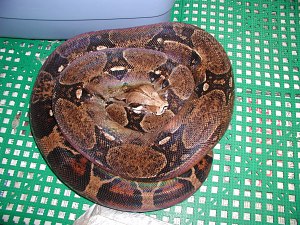 Common name: Boa Constrictor
Common name: Boa Constrictor
Homeland: Bolivia, Brazil, Columbia, Central America. Peru, Trinidad, Tobago and Venezuela depending on the type of boa.
Size: can reach up to 14 feet
Lifespan: 20-30 years
About the Boa
They are so cool, I just love them.
Not every Boa is a red tail boa. Yes, there are many different boas just like there are different kinds of elephants. Ever see the ears on an Indian elephant in comparison to an African elephant? If you don’t know what to look for it is easy to confuse them. Also, most pet shops don’t make it much better calling every boa they have a red tail boa. So first, I will give you some of the differences between the most common kept boas and then discuss how I care for them since there care is similar. Other boas such as my Dumerils and Rainbow boas will have their own carepages.
"Boa Constrictor Constrictor”
If there ever was such a thing as a true Red-Tail Boa this was it. If you look at the tail pattern or “saddles” (usually less than 22 altogether) they look somewhat red compared to the saddles higher up on the boa. This often fades as they grow. They usually have an awesome shape like a bat!
I have never seen one bigger than 8 feet but I read that the female Boa Constrictor Constrictor can reach 12 feet and 60 pounds with the males around 8.
“Boa Constrictor Imperator”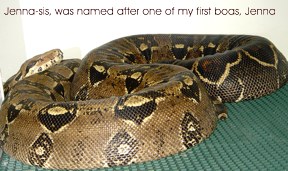
This snake is mistakenly referred to as the Red-Tail Boa, heck, every Boa I hold at shows people call a Red-Tail Boa, even my pythons! Boa Constrictor Imperators are from Columbia and parts of Central America. The females will grow quickly to about 9-12 feet and the males get to be around 8-10 feet. They usually have more saddles than the boa constrictor constrictor.
Argentine Boa Constrictor
These guys are much darker in color. Usually dark brown if not black. Some have really defined pattern broken with almost white lines and this can be so beautiful.
They are much more active at climbing than the other two I have mentioned. From what I know these tend to grow the largest. 10-14 feet is not unusual if cared for properly. Mine is almost 9 feet now.
Now on to how I care for them…
Temperament
Before you take on a boa (I hope you are adopting one in need and not buying one) be sure your dedicated to caring for the animal. Large Boas can live to 30 years. That means 30 years of cleaning poop, feeding, watering and more. It's like having a child that will always need your care so don’t start if your not in it for the long haul.
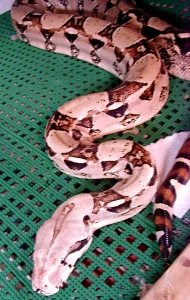 “Boa Constrictor Imperators” may be more popular than “Boa Constrictor Constrictor” because they have a reputation for being a bit tamer. I cannot confirm as to one being more aggressive than the other but every one of my boas were rescues and often come to me very ill and quite aggressive. The good news is given proper caging, heat, humidity, treated with care and proper diet they are all tame pets doing shows with me.
“Boa Constrictor Imperators” may be more popular than “Boa Constrictor Constrictor” because they have a reputation for being a bit tamer. I cannot confirm as to one being more aggressive than the other but every one of my boas were rescues and often come to me very ill and quite aggressive. The good news is given proper caging, heat, humidity, treated with care and proper diet they are all tame pets doing shows with me.
Boa Constrictors are very common in the pet trade but I have always said “just because and animal is at a pet shop does not guarantee it will be a good pet. They can deliver a nasty bite. A big bite from a big boa can require stitches.
A baby boa hatches at about 14-22 inches and can grow up to 5 feet in length its first year. This growth will slow down in its second year but will continue to grow until it reaches its full length for its species.
Purchasing a Boa
If you have the money, space and desire to raise a boa I hope you would look into adopting a boa in need before you purchase one. Drop me an e-mail and I will have my staff try to find a local rescue to help you but let's all work together to get boas in need a home before we give money to pet shops that take these beautiful creatures from the wild and force them into captivity.
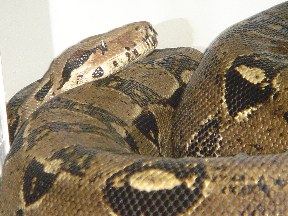 If you choose not to adopt and are considering buying from a pet shop,:-( here are a few concerns about your purchase. If you feel you can trust your local pet shop, great, but you might do better by going directly to a breeder. Not on price but at least you have a fair assumption they are captive bred, not wild caught. Never buy wild caught. Not only is it wrong chances are it will be sick. This is my experience. I have seen it often. Wild caught snakes with ticks, mites and who knows what kind of diseases. Usually captive bred is a safer way to go and also seem to be more docile.
If you choose not to adopt and are considering buying from a pet shop,:-( here are a few concerns about your purchase. If you feel you can trust your local pet shop, great, but you might do better by going directly to a breeder. Not on price but at least you have a fair assumption they are captive bred, not wild caught. Never buy wild caught. Not only is it wrong chances are it will be sick. This is my experience. I have seen it often. Wild caught snakes with ticks, mites and who knows what kind of diseases. Usually captive bred is a safer way to go and also seem to be more docile.
Have the owner or pet shop employee take the snake from its enclosure. Watch how he picks it up. Is the owner gentle? Is the snake moving back as if afraid? Does the owner show hesitation? These are clues as to what you are getting, pay attention. When picked up, the snake should slightly grip your fingers as it crawls around. Larger snakes will tighten on your hand or arms. This action is usually them holding on and not to be confused with trying to strangle you.
Next, ask if you can see it feed. Is it being fed live animals? (See my “general care page” for more info on this) Live prey can harbor all kinds of problems and there is a good chance you will have an extra vet bill to de-worm him. If the boa you want is only a month or two old you may never know if it has eaten. Some will hatch and never eat. They may not even know if it has eaten yet.
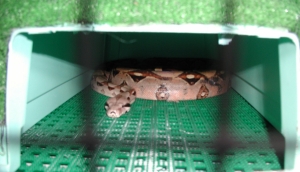 Next look over the skin for cuts or wounds possibly inflicted during a feeding or from another snake. This can happen when they keep more than one snake in a cage. It should be caged alone. If not, whatever illness its cage mates have it may have. Is the cage it is in clean? Check the water bowl for a slimy film on the sides. That will let you know if it is cleaned daily as it should be. If not it could lead to disease. Now look at his Vent, that’s the poop shoot! Is it clean? Look closely around the eyes and vent area for mites. Little white or reddish brown bugs moving about on the snake and under scales. These are killers to a boa if left untreated and can bring disease. Run your finger along the spine to feel for irregularities such as bumps or bends.
Next look over the skin for cuts or wounds possibly inflicted during a feeding or from another snake. This can happen when they keep more than one snake in a cage. It should be caged alone. If not, whatever illness its cage mates have it may have. Is the cage it is in clean? Check the water bowl for a slimy film on the sides. That will let you know if it is cleaned daily as it should be. If not it could lead to disease. Now look at his Vent, that’s the poop shoot! Is it clean? Look closely around the eyes and vent area for mites. Little white or reddish brown bugs moving about on the snake and under scales. These are killers to a boa if left untreated and can bring disease. Run your finger along the spine to feel for irregularities such as bumps or bends.
If you can gently open its mouth by pulling on the skin under his jaw. Look at and in its mouth for signs of “Gunk” is it clean? No cheesy build up or red spots. It should be very clean.
Check out its eyes. Do they respond to light the way your pupils do?
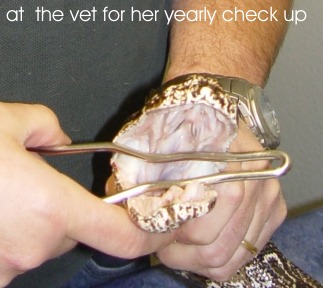 And don't forget to listen for any sound such as a “Wheeze” or gasp. Too often you will here the seller say it just a slight Respiratory infection. These infections can kill a snake if untreated. Sometimes you can get rid of it with heat and antibiotics but don’t risk it.
And don't forget to listen for any sound such as a “Wheeze” or gasp. Too often you will here the seller say it just a slight Respiratory infection. These infections can kill a snake if untreated. Sometimes you can get rid of it with heat and antibiotics but don’t risk it.
This is just a brief overview of what to look for in acquiring a new boa. I have not gone too far in depth but hopefully given you a little to arm yourself with. When you have your new baby, or big baby, always make a trip to the vet for a check up. Also, bring your vet a stool sample as well.
Now on to what to do when you have it in your home…
Let it sit in its new cage for a week and leave it alone. Give it time to adjust. I know the temptation to play with your baby is powerful but you may stress him out. The 8th day is a good time to feed him a small meal. Give him a couple of days to digest and on the 10th or 11th day take him out for 10 minutes.
If you have a large snake slowly and gently cover his head with a spare towel then reach to his midsection to pick him up. Pull him out from under the towel and let him do the moving at first. Let him treat you as if your furniture. Just let him climb. Remember in the wild when something picks them up it is to eat them. You will need to get him used to the fact you mean no harm. This may happen in a day or two or a few weeks. It's up to your new baby to decide. Don’t rush or get discouraged.
Move slowly; never move your hand directly at the face. Always come from under and behind the snakes head. If you do get bit, baby snakes scare you more than they hurt, but it does hurt. If you’re holding a big guy you should have someone there to help dial 911. Just kidding about the 911 part but it is strongly advised not to handle any boa over 6 feet long alone. A bite could require stitches or if it gets you on the face or eye you will be in need of help. Yes they CAN bite but I told you that already didn’t I?
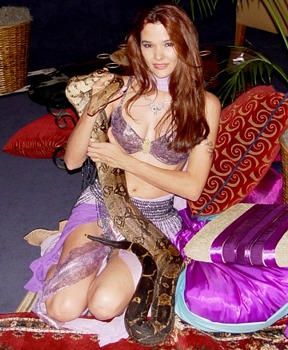 So for the first few days you’ll keep it at a slow pace of 10 minute sessions and slowly move up to twice a day for 10 minutes or 3 times. You will get to know your snake’s temperament and you can decide the pace to progress. This is only a guideline I suggest.
So for the first few days you’ll keep it at a slow pace of 10 minute sessions and slowly move up to twice a day for 10 minutes or 3 times. You will get to know your snake’s temperament and you can decide the pace to progress. This is only a guideline I suggest.
Cages
If your boa can reach a size of 12 feet how big do you think your cage should be? This is such an important decision to make before you get the snake. Do you have the space for such a large snake? If yes then I would suggest you give it as much space as you can. A 12-foot snake would use a 15-foot cage if you give it to him so if you can please do. I’m not the boss of you (although I should be) but if I was I would say the minimums should be a size I have called the “L” size.
I hope I get this across right if your snake is 10 feet long then a cage that is 5 wide x 5 deep would be fine. Or a cage 4 deep by 6 wide, get it? A 12-foot snake would be somewhat comfortable in an 8x4 and so on. Of course longer than the snake is best. As for height I suggest again all you can give it. Boas will climb if given the space. My 8 and 9-foot boas (especially my Argentine boa) are often found on the top shelf of their cages or climbing across tree limbs I have placed on the top of the cage. Mine are all 5 feet high. Give it some thought. At least 4 feet high. You can make it so you get him out from the front and use the top for a table for cleaning supplies or handling area.
Substrate
I went over that on my general care page. I only recommend Dri-Dek rubber mats.
Inside the cage
A hide house is a must. Two would be better. They need a place they can retreat to and feel safe. A dark, cave like spot, not too big, where the reptile can feel the walls while they sleep. Being able to touch all sides give them a feeling that nothing can sneak up on them while they rest. Place one on the hot side and one in the middle range. Avoid having it on the cool side. Boas will often retreat to a hide house after eating to relax and digest but if it is on the cool side it can lead to problems. A hide house can be any kind of tight enclosure in the cage a snake can go into and be completely out of sight. A cardboard box, a half log or as I use for my big boas the top half of a Kennel Carrier. It is plastic, strong and easy to disinfect. Small private areas to hide are very important if you have a small snake in a big cage.
Heating your boa cage
A proper temperature is life and death to a Boa. Don’t be negligent here.
Your boa needs to be kept at a temperature between 78-88 degrees with a basking spot up to 90 degrees. Try not to let it get hotter than 92, if it gets too hot your snake may not use it at all, which may lead to health problems.
Since you HAVE a large enough cage you will make a temperature gradient allowing the Boa to move to the temperature he needs.
This is done by placing your heat panel, (see my general care page) not a bulb or heat tape, but a safe heat panel on one side of your cage near a shelf to create a basking spot that reaches 90 degrees. Set your thermostat to the proper temperature and check the temperature on the farthest side of the cage. Is it at 78 degrees? Then your set.
Place several thermometers in the cage. On the ground at both sides, at top and bottom. Keep an eye on these. If you can keep this temperature gradient constant you eliminate most of the health issues your boa may have to deal with.
Humidity
This is a hard one. The above-mentioned boas need humidity to reach 50-60%. First go to my general care page and read my section on humidity.
Now, if you have a large boa I would prefer you have a water bin in the cage large enough to let the boa soak. Rubbermaid storage bins do fairly well but when it comes to emptying and cleaning the weight of the water is problematic. But this large surface of water is what can create the humidity your boa needs. A couple of water bowls wouldn’t hurt to raise the humidity in the cage. I have an inexpensive steam vaporizer going 8 hours at night to bring my humidity to the level I need, you may want to look into this. There are also misting systems you can use. They even come with timers so you can set it to spray throughout the day. Of course a simple spray bottle from the plant department of Wal-Mart or Home Depot work fine as long as you do spray once or twice a day.
Now that you have the humidity you must remember that humidity can help germs breed so clean often. Wipe down those walls. I use a Swiffer mop sprayed with a veterinary disinfectant. One wipe and I am done. Mold can cause terrible lung problems so please keep it clean.
Feeding your Boa Constrictor
First, go back and read my general care page about frozen/thawed food. I get my rodents at www.rodentpro.com
Boas can be fed mice, rats, hamsters, guinea pigs, gerbils, and rabbits. Rats are more of nutritional values but I have fed all at some time. Variety is always better. You would do best to offer rats and rabbits. Guinea pigs are high in fat, I use those to fatten up snakes that are under weight. But too many feedings with Guinea pigs can be bad since the hair is so think. Just like with rabbits. So alternate between appropriate sized rats and rabbits and you should not have a problem.
Boas are usually active at night. Often they like to feed at night but I feed any time of day. I don’t seem to have a problem but it is something to keep in mind if you have a problem eater. How big of a rat? Feed food that is no larger than the largest part of your boa’s body. A newborn boa would be eating a small mouse. Don’t go too large, it can make them puke. Sure its funny when your friends puke but a snake can be seriously hurt from it. Remember since they swallow food whole, teeth claws and all, they can hurt themselves when they vomit. Toenails can scratch or even cut them on the inside since vomiting is more violent than the slow way it goes down. Add the stink of a half digested rat and you may puke too. Just a reminder do not handle the boa or any snake for at least 48 hours, if not more, after eating.
Do not over feed. Young snakes should get one food item of appropriate size every 5-7 days. Once they reach 3-4 feet in length you can feed them every 10-14 days. Over feeding can shorten the lifespan of your boa and cause other health risks.
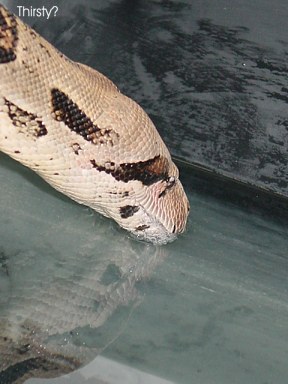 Water for your Boa Constrictor
Water for your Boa Constrictor
First, go back and read my general care page about water.
This is so easy for boas as babies. I prefer to use Rubbermaid bins large enough for the snake to soak in. They are removable which make them easy to clean because you are going to clean often, every day right? ok, now you got that down but what to do with a 20 pound boa. You will need a huge water bin. This means a lot of work to change and disinfect but you must. Water is a great place for bacteria to grow and if you don’t clean you will end up with a sick snake, really sick. Cleaning is very important. Some people keep small water bowls like the heavy ceramic kind for dog’s drinking water and give their snakes a soak weekly in their bathtubs. Hope this helps, let me know how you do?
Comments: If your really want a big snake this one tends to be the better way to go over a python. Not as big and a bit easier to care for. I still suggest a Ball Python. And don't forget they still require a lot of attention to be docile and need to be kept very clean to avoid infections.
Comments: If your really want a big snake this one tends to be the better way to go over a python. Not as big and a bit easier to care for. I still suggest a Ball Python. And don't forget they still require a lot of attention to be docile and need to be kept very clean to avoid infections.